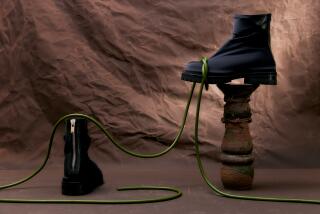The trend hits hotels too
- Share via
For years, hotels were largely cookie-cutter boxes with sterile-white walls, industrial carpets and overly practical matching beds, nightstands and chairs. Then came the irreverent, sometimes wild boutique styling, complemented by kitschy themed decor in Vegas. Luxury hotel operators discovered, however, that weary travelers longed for rooms that were less like mini-amusement parks and more like sanctuaries with the familiar comforts of home.
Today, upscale hotel rooms could pass for a tasteful person’s well-designed guest bedroom. The mix of furniture and accessories seems to have been thoughtfully collected over time. Guests might find floors of marble or hardwood, walls of buttery yellow, light emanating from soothing pendant lamps, not blasted from overhead. Push-button espresso machines and other pampering provisions -- think giant soaking tubs -- promote relaxation and romance. Just as in L.A.’s restaurant scene, designers whose background is in residential interiors are converting public spaces into home-like havens.
“Hotel rooms transformed from generic sleeping chambers into sexy, custom spaces to languish in,” says Christopher Lowell, who is overseeing the design of Shade, a boutique hotel in Manhattan Beach scheduled to open in August. “Hotels understand that sophisticated travelers expect these comforts and they are looking for home design ideas.”
Using top-quality materials and homey touches makes guests want to stay longer, return sooner and, perhaps, order some of the designs to go.
“Home is a mood,” says Cheryl Neumann, whose Dallas company, Wilson & Associates, designed the 262 guest rooms for the Montage Resort & Spa in Laguna Beach, which sells its line of furniture and bedding. “A hotel room needs to be nurturing and inspiring.”
At the Montage, the plantation-style mahogany bed frame shares the room with a blond-leather caned bench and gold-plaid corner settee. Underneath it all is sand-colored nubby carpet. Each piece of early California art has a different style of frame. “It’s costly and more time consuming to put these elements together, and the room is harder to maintain,” Neumann says. “But it’s more romantic and people respond to that feeling. Even if they’re alone on a business trip, it still makes them feel good. They notice it.”
At Shade, Lowell “tricks people into relaxing.” He designed frosted-glass shoji-like screens to wrap around the aromatherapy soaking tub plus a table that stretches across the bed and rolls on a track. A nearby dial changes the intensity and the color of the lights, from stress-reducing vanilla to sensuous amber. “Eat, work or have fun there,” Lowell says. “We’re doing more in bed than we think we do, and given the option, we’d do even more.”
Relaxing colors -- deep putty, sea-foam green, warm taupe, baby blue -- are replacing walls and ceilings once awash in white and beige.
“Traveling has become so difficult that guests want a room that envelops them,” says Armella Stepan, vice president of business development of Shutters on the Beach. The recent “reinvention” of the guest rooms at the Santa Monica hotel was designed by Michael S. Smith, who specializes in residential interiors, not hotels. “That was intentional,” Stepan says. “Michael has added a sophisticated yet warmer feel.”
Hardwood floors, common in homes but rare in hotels, have been installed. Rooms have a supply of classic movies to play on the thin-screen TV, and desk drawers hold staplers and paper clips, “as you would outfit your home,” Stepan says. “We have done everything to make our guests feel as if they are in a very expensive, very comfortable beach house where it’s OK to go barefoot and put their feet up.”
The new Chamberlain West Hollywood, formerly a Summerfield Suites by Wyndham, opened this month with a home feel already in place. The four-story structure was originally an apartment building, one whose floor plan was kept intact by owner Kor Hotel Group, which also runs Viceroy in Santa Monica and the Avalon in Beverly Hills. The 550- or 650-square-foot guest units have sunken living rooms with fireplaces, and pantry service will deliver organic cereals, a selection of fresh olives and other edibles to the kitchenettes. The hotel’s slogan: “In Town. In Residence. In Style.”
The added amenities now leave hotels contending with guests who pack up not only the towels but also Chinese antiquities, cordless phones and crystal glassware.
“That’s the price of doing business,” says Tery R. Young of San Francisco-based Boxport, which supplies hotels with luxury goods. “But since many are selling these items, guests know upfront what they cost. It’s still the honor system, but hotels are watching.” And they have your credit card number.
More to Read
Sign up for The Wild
We’ll help you find the best places to hike, bike and run, as well as the perfect silent spots for meditation and yoga.
You may occasionally receive promotional content from the Los Angeles Times.






